Small€ˆmunsterlanders & woodcock.
By Don Knaus
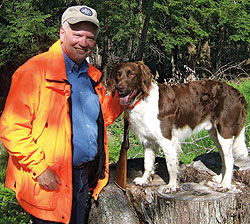 The author with Mike Bowser's Dieter. |
"Don, I've got lots of paint here." My hunting companion, Mike Bowser, was not referring to latex enamel. To the uninitiated, "paint" is woodcock droppings. When the migratory timberdoodles settle in for a few days, they leave a telltale whitewash on the russet autumn leaves. Mike was letting me know that there were woodcock nearby. I had barely digested that thought when he shouted, "Don, we've got a point."
His Small Munsterlander, Dieter, was frozen, his nose aimed at a game bird. Its protective coloring rendered the bird virtually invisible against a background of dried leaves. Mike edged in from the side. When the woodcock flushed from underfoot, it zigzagged off through the brush with a whistling of wings. I didn't have a shot but the bird fell quickly to a dose of No. 8s from Mike's 28 gauge.
Mike and I are both "long in the tooth" and we had decided that this hunt would be just a few hours. In that time, we flushed 12 woodcock and three grouse. As we neared Mike's jeep, Dieter went on point again. We slowly moved in. Then the dog broke point and circled out about 25 yards.
Mike noted, "He's got a runner, Don. He's heading it off." We heard a few clucks and two wild turkeys took flight, flapping within easy shotgun range. We both made phantom shots and smiled. It wasn't turkey season yet and, besides, it's illegal to hunt them with a dog in Pennsylvania. Still, it was a great experience.
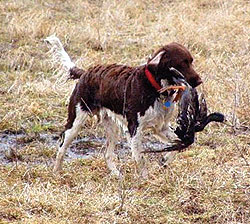 Dieter fetches a duck--besides hunting upland game, the dogs eagerly retrieve waterfowl. |
I was introduced to the Small Musterlander breed about a year ago. At the daily meeting of the "Fur and Feather Filosophical Society" at the Wellsboro Diner, Mike announced, "I got my Small Munster." Thoughts of specialty cheese rushed into my head. Then he explained that he had taken ownership of a Small Munsterlander — a hunting dog.
The day after our brief sojourn in the poplar and white pine slashings, Mike was expecting members of the Northeast Chapter of the Small Munsterlander Club of America to arrive at his place. He was hosting eight fellow Munster owners for three days. They were following the flight of the woodcock.
The American woodcock (Philohela minor), sometimes called bog-sucker, uses its long bill to feast on earthworms. Their southern migration stays ahead of the frost. While they often are found near bogs, in the mountains of north-central Pennsylvania they are more likely to drop into aspen patches or sections of clear-cut forestland. And Mike was ready for the woodcock flight and for the Munsterlander owners.
He had visited the local offices of the Department of Conservation and Natural Resources (DCNR) to find out where, within the nearby million-plus acres of state lands, clear-cuts had been made. Each area was marked out on topographic maps. The cuts were also color-coded to indicate the dates in which they were timbered. Then he made copies so that each hunter could have his own map of the timberdoodle hotspots. Mike selected only public lands as he didn't want any of his buddies to get hassled by private landowners.
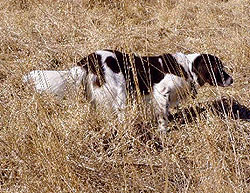 Linus on point. |
The bonus bird was grouse. It just so happens that clear-cuts and ideal woodcock cover are equally ideal for grouse. They came for the woodcock flight, but the Munster clan actually put up more grouse than bog-suckers.
The Small Munsterlander is recognized and certified by the North American Versatile Hunting Dog Association (NAVHDA). The breed can point upland game, retrieve on command and they will eagerly swim in murky waters to pick up waterfowl. Their most admirable trait is the love they show to humans. I've met a number of Small Munsterlander dogs and their masters, and I've yet to find a Munsterlander that was not housed in its owner's home.
Extremely lovable, the dogs crave affection but they understand acceptable standards of behavior. So valued are the Munster pups, John Liscovitz and his son, Sam, drove in all the way from Illinois to pick up a pup from Solon Rhode, who hails from Vermont.
Bay State resident Paul Jensen, the acknowledged "Godfather" of Munsters in America, introduced the breed in the United States in 1974. Paul, a native Dane, brought the dogs with him when he chose to become an American. The breed is so closely monitored there are currently fewer than 500 Munsters in the U.S.
I was invited to breakfast with the Munster owners at the diner. I was to get a total immersion into the Munsterlander clan. These dog owners might be called mensches for Munsterlanders. A mensch is someone to admire and emulate, someone of noble character. The key to being "a real mensch" is nothing less than character, rectitude, dignity, and a sense of what is right and responsible. And nothing could be nobler of character than the owner of a Munsterlander sporting dog.
The whole purpose of buying a Munsterlander is to be a responsible dog owner and trainer. Munsterlanders certainly have a sense of what is right when it comes to breeding, buying, training and hunting that special breed of bird dogs. The owners of Munsterlanders are so covetous of the legitimate breed name that they impose strict breeding guidelines. They actually refuse to submit their breed for acceptance to the American Kennel Club (AKC) because they believe that unscrupulous breeders and puppy mills have watered down the quality of too many AKC breeds.
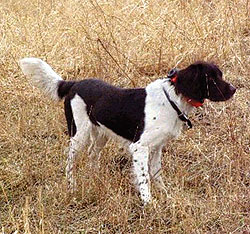 Appi on point. |
If one should be chosen to own a Munsterlander, he or she will get, at a minimum, a three-generation family tree from both the sire and dam. Both the parents will have proven field trial and hunting credentials. A potential Munster owner should note that the breeder will likely check you out more than you scrutinize his pups. To maintain the integrity and purity of the breed, people who purchase a pup agree to only breed the Munster after
it has passed the NAVHDA field tests, where the dogs are scored on criteria that include eagerness to hunt, pointing game, retrieving (both land and water), etc.
I've been around bird dogs before and I owned a Brittany for years but I've never seen dogs as good as these. Most birders are loath to let their pooches run rabbits and the pointers, setters and spaniels are quickly pulled off a bunny trail. No one was allowed to shoot a rabbit while hunting with a regular bird dog. I was amazed when we kicked up a rabbit and the Munster master said, "If you want to take rabbits go ahead."
The hunters I hung with for four days were all members of the Northeast Chapter of Small Munsterlander owners and they enjoyed the camaraderie as though they were members of a close-knit fraternity or a secret society. Paul Jensen was there to hold court. Everyone renewed friendships. The group joins forces to help train and test their dogs.
Field tests are important.
Mike had a less than perfect score on his dog, Dieter, at a NAVHDA test. The breeder "grandparent" of Dieter, Mark Bulvanoski, drove five hours to Mike's place to help correct the water hesitation. The fix involved wiring a steak--yes a steak--to a retrieving dummy bumper. Dieter was eagerly plunging into freezing water within minutes.
I quizzed the hunters after their first two days, and I couldn't believe it. For the group's first two days of hunting on public lands, two groups, one of three men, one of four, and their Small Munsterlanders had 64 grouse flushes and 48 woodcock flushes. The refrigerator at Mike's place was groaning with the weight of three five-quart bowls filled to overflowing with the cleaned game birds.
I truly enjoyed the company of the Munster owners. All were very personable guys and I would hunt with any one of them anytime. And I will add that these guys are dedicated to their dogs. I stood in Mike's kitchen, soaking up the pleasant hunting banter. It was suppertime--way past my suppertime. The men had been hunting hard since early morning. None had returned to Mike's place before the end of legal shooting time.
They must have been famished. Henri, from New Jersey, opened a four-pound package of hamburger and began sautéing the ground beef. I assumed that was the beginning of the evening meal preparation. I thought maybe spaghetti sauce or sloppy joes. Nope. The tasty burger was to be mixed with high protein dog food for his dog. He finished and Solon began cooking burger for his dog.
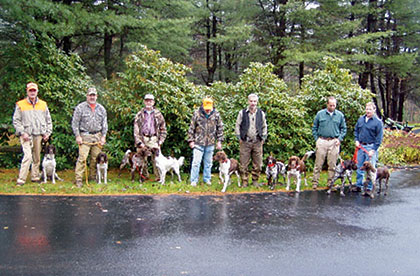 Northeast Chapter members and their Munsters. |
Solon had perhaps the least luck of the entire crew. Most limited out on woodcock and grouse at least one of the three days. As Solon stated, "I had 18 flushes of grouse in two days of hunting, but I never did kill a grouse. One problem was we were hunting a little too close together and a number of really good looks I got at grouse, I couldn't shoot for safety reasons. Some of the grouse flushes came out of trees and some were only heard. I had 23 flushes of woodcock and did get some nice points and kills with them."
On day three, I wangled a short trip with Mark for just two hours. I had to leave before the hunt was over but, in that short period of time, we had 10 grouse and 12 woodcock flushes. I always seemed to be in the wrong place and only got a single shot at a timberdoodle — which I hit. The bird had a broken wing and ran. The dogs quickly picked it up and retrieved it.
Mark had many more shots than I did and he scored on two grouse and three woodcock, the daily Pennsylvania limit for each bird. As we walked back to my truck, I asked Mark where he got his dogs. He replied, "Well, Caja is out of a male from Germany and a female from Denmark. Bou is from Germany."
"You mean he was shipped to you from Germany?"
"No. I went to Germany to pick him up." Noting the incredulous look on my face, he added, "I wanted to see his parents. I wanted to meet the breeders and sit at their table. Have supper with them. Heck, 500 for plane tickets is a small investment for a good Munster."
Munsters. I can vouch for the breed and their owners.
For more information, check out the club's website: www.smallmunsterlander.org.
Don Knaus has written about hunting and fishing for years. He writes a weekly outdoor column for three newspapers and is the author of The Small Munsterlander, a history and training manual for the breed. His book Of Woods and Wild Things is a recent publication of short stories dealing with hunting, fishing and the outdoors. Both books may be ordered at his website, www.donknaus.com.






